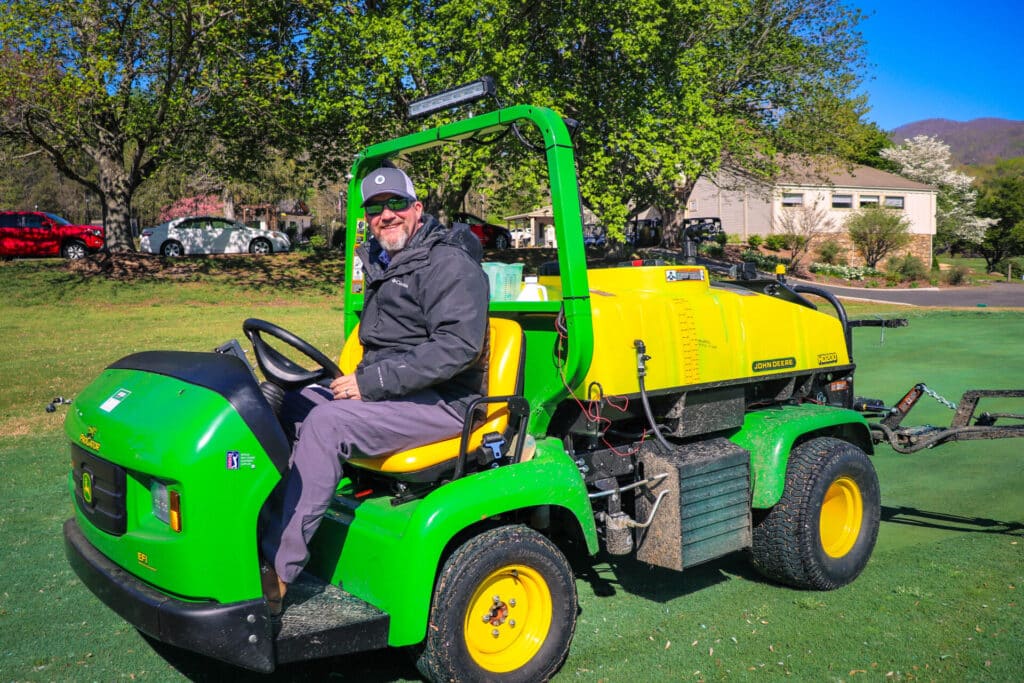With Lance Allen, GCS – Bald Mountain Golf Course
May is here, soil temperatures are on the rise, and our warm-season turf around the property is starting to green up and grow. Well, most of the grass is waking up, but the extreme temperatures and ice in the winter of 2024-2025 have small areas of turf in isolated environments struggling to break dormancy. “Winterkill” is a term that has turf managers extremely nervous in the spring of every year as we wait to see what grass has not survived the winter. This year, in Lake Lure, the past 7 months have been downright brutal in the weather department. Helene, followed by 6 weeks with no rain and much of that time with no irrigation due to power outages or destroyed infrastructure, followed by a very frigid winter, had turf managers in our area wondering what May would bring.
 In my experience, most “winterkill” occurs in one of two scenarios. The first one and easiest to forecast are areas where snow and ice accumulate and do not melt completely for multiple days. Those freeze and thaw cycles create a sheet of ice that cuts off the air and sunlight to the crowns of the plant, killing it. The reason these areas are easier to forecast is that they are usually on the edges of the property, where the combination of shade and short winter days does not supply enough light to melt the snow. Other things that complicate growing grass in these areas are poor irrigation coverage and cart traffic, which prevent the turf from getting strong and thick during the growing season and leave it vulnerable during the winter months.
In my experience, most “winterkill” occurs in one of two scenarios. The first one and easiest to forecast are areas where snow and ice accumulate and do not melt completely for multiple days. Those freeze and thaw cycles create a sheet of ice that cuts off the air and sunlight to the crowns of the plant, killing it. The reason these areas are easier to forecast is that they are usually on the edges of the property, where the combination of shade and short winter days does not supply enough light to melt the snow. Other things that complicate growing grass in these areas are poor irrigation coverage and cart traffic, which prevent the turf from getting strong and thick during the growing season and leave it vulnerable during the winter months.
The other scenario is far more difficult to forecast and can affect the actual playability of the golf course. Most people think that cold temperatures alone can cause “winterkill.” In most cases, it is a combination of two or more things that escort the turf to its eternal resting place. Cold temperatures certainly do not help with warm-season turf health, but often, moisture has more to do with “winterkill” than cold temperatures. Desiccation or drying out when temperatures are cold is the quickest way to lose turf in the winter. They should change the name of “winterkill” to “winter desiccation” because, in most cases, the cold temperatures and lack of moisture are the leading contributors to problems on greens, tees, and fairways.
Given the circumstances, Rumbling Bald has weathered the winter of 2024 and 2025 wonderfully. There are areas that need to be addressed, but overall, Matt and the staff did a fantastic job given the daunting set of obstacles put in front of them starting in September. The greens at Apple Valley are in great shape despite having the covers on them for the majority of January and February. Covers are a great tool, but do not come with any guarantees. Clubs must depend on the professionals that they put in place to make the tough decisions and do the right thing every day.




